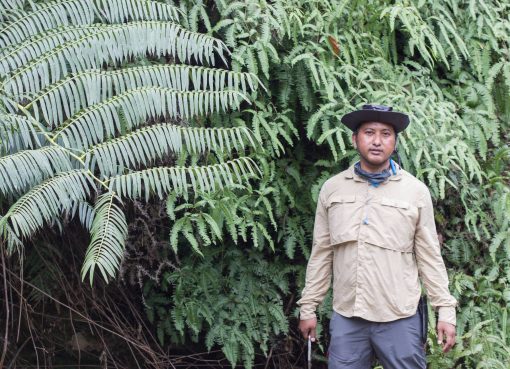Dr. H.T. Lalremsanga
Born on 14th February 1979, Dr. H.T. Lalremsanga is currently working as the Professor & Head, Department of Zoology in Mizoram University. He did his MSc in Zoology from North Eastern Hill University (NEHU), Shillong in the year 2002 with NET-JRF under CSIR-UGC and thereafter completed his PhD from the same university in 2011. He joined the Dept. of Zoology, Mizoram University in 2007 and was subsequently promoted to the rank of Professor in the same department in 2021. His specialization is in the areas of Developmental Biology, Herpetology, Biosystematics, Taxonomy, and Animal Ecology.
Prof. H.T. Lalremsanga is actively engaged in organizing environmental conservation awareness activities among local people and various institutions. His current research area is mainly on inventory survey, taxonomy, biosystematics, snake venom, and the biology of fauna and flora of Mizoram. His works revealed causative agents of seasonal change in the colouration of Rih Dil erasing earlier mythological beliefs, and the biology of amphibians and reptiles. Moreover, he is an active campaigner for snakebite management, rescued hundreds of snakes when he survived three times after being severely bitten by cobras and vipers, helped snakebite patients to get anti-venin and also collaborated with Premium serum (Pune) for supplying an adequate amount of anti-serum in a lower cost, especially for the rural areas. He also prepared more than 20 video documentaries for creating awareness of the fauna (especially on the biology of snakes, other reptiles and amphibians) of Mizoram, and released a book of Snakes of Mizoram (Mizoram Rul Chanchin) in local languages. His works have significantly motivated the local people to change their attitude towards snakes, their conservation and snakebite management leaving traditional beliefs.
He is among the founder members of one of the biggest non-profit, environmental NGOs in Mizoram, Biodiversity and Nature Conservation Network (BIOCONE) in 2009 and won the Balipara Foundation Annual Award 2015 during his Presidential term for their contribution towards nature conservation in Mizoram. He already published more than 188 scientific papers in various reputed and peer-reviewed international journals. He also contributed 21 book chapters and two books. His research team has generated genetic data of most amphibian and reptile species of Mizoram; described new species of frog, Leptbrachella tamdil (Amphibia: Anura: Megophryidae), limbless amphibian, Ichthyophis benjii (Amphibia: Gymnophiona: Ichthyophiidae), eight new species of bent-toed geckos (Cyrtodactylus aaronbaueri, C. agarwali, C. bengkhuaiai, C. karsticola, C. exercitus, C. lungleiensis, C. ngopensis and C. siahaensis (Reptilia: Sauria: Geckonidae), parachuting gecko, Gekko mizoramensis (the only known species of parachuting lizard in Indian mainland), a swamp-eel Monopterus ichthyophoides (Teleostei: Synbranchiformes: Synbranchidae), two natricid snakes like Herpetoreas murlen and Blythia hmuifang (Reptilia: Serpentes: Colubridae), a new green pitviper Trimeresurus mayaae (Reptilia: Serpentes: Viperidae) and a new genus and new species of natricid snake, Smithophis atemporalis (Reptilia: Serpentes: Natricidae) from Mizoram; revalidated two slug-eating snakes, Pareas modestus and Pareas jerdoni (Squamata: Pareidae); elevated two subspecies of coralsnakes Sinomicrurus iwasakii and S. swinhoei (Squamata: Elapidae) at full species level; rediscovered reptiles (Liopeltis stoliczkae, Lycodon septentrionalis and Oligodon catenatus) and amphibian (Chirixalus doriae), added many new state and country faunal records for both amphibians and reptiles; resolved the systematics of barred wolf snakes in the Lycodon striatus complex; discovered three clades from the evolutionary lineages of a deadly venomous Banded krait (Bungarus fasciatus) complex like Indo-Myanmar, East Asian and Sundaic clades; delimited the renowned viper, Pope’s pit viper (Trimeresurus popeiorum) into India, Bangladesh, Myanmar and Southern China, while the rest of known earlier eastward species need further verification.
With collaborators, venomic properties of deadly venomous snakes like Green pit vipers (Popeia popeiorum, Trimeresurus erythrurus, T. septentrionalis and Viridovipera medoensis, Banded krait (Bungarus fasciatus) and cobras (Naja spp.) prevalent in the region have been characterized and his work also led to disproval of the efficacy of Indian antivenom products via cross-reactivity test.
He is frequently invited as a resource person in various international/national/state-level seminars/workshops/training/conferences held in various institutes. His team had been actively engaged in conservation awareness programmes and rescuing wild animals in various parts of the state. He is also actively engaged as a member of 25 professional committees. He also completed five extramural research projects as the Principal Investigator including three international projects and currently pursuing seven ongoing projects.
Prof. Lalremsanga has been recently awarded International Herpetological Symposium (IHS), USA Grant Award 2021; Rufford Foundation, UK 2022; The Habitats Trust Grant Award 2022; Chicago Board of Trade Endangered Species Grant Award 2023 (Chicago Zoological Society). He is also a recipient of the Special Science Award 2023 from the Department of Science and Technology, Govt. of Mizoram for his outstanding contribution to research in science benefited by local people.
Prof. Lalremsanga is a member of the IUCN Viper Specialist Group, IUCN Species Survival Commission (SSC) Amphibian Specialist Group (ASG) 2021-2025, German Society for Herpetology & Herpetoculture and Mizoram State Biodiversity Board. He is also a reviewer of seven reputed peer-reviewed journals.
Under his research guidance, more than 40 MSc dissertations and three (3) PhD and two (2) M.Phil. theses had been submitted and awarded. At present, six (6) MSc students and 12 PhD scholars are working under his supervision in different fields like amphibian biology, herpetofauna of various Community Reserved Forest, the biology of carnivores and primates, cicada diversity, evaluation of medicinal plants, biological management of pests by using Entomo-Pathogenic nematodes (EPN), identification and molecular analysis of parasites found in snakes, morphological and molecular analysis of scorpions, reptiles and amphibians, etc.





